warning FIAT DOBLO COMBI 2015 2.G Owners Manual
[x] Cancel search | Manufacturer: FIAT, Model Year: 2015, Model line: DOBLO COMBI, Model: FIAT DOBLO COMBI 2015 2.GPages: 323, PDF Size: 46.77 MB
Page 189 of 323

FUEL CUT-OFF
SYSTEM
This intervenes in the case of an
impact causing:
❒the fuel supply cut-off with the engine
consequently switching off;
❒the automatic unlocking of the doors;
❒the switching on of the interior lights;
❒switching on of the hazard warning
lights (to deactivate the lights press
the dedicated button on the
dashboard).
122)
When the system has been
triggered, the message “Fuel cut off,
see handbook” is displayed on
some versions.
Check carefully for fuel leaks, for
instance in the engine compartment,
under the vehicle or near the tank
area.
After a collision, turn the ignition key
to STOP to prevent the battery
from running down.
The following procedure should be
carried out to restore the correct
operation of the vehicle:
❒turn the ignition key to the MAR
position;❒activate the right direction indicator;
❒deactivate the right direction
indicator;
❒activate the left direction indicator;
❒deactivate the left direction indicator;
❒activate the right direction indicator;
❒deactivate the right direction
indicator;
❒activate the left direction indicator;
❒deactivate the left direction indicator;
❒turn the ignition key to the OFF
position.
WARNING
122) If, after an impact, you smell
fuel or notice leaks from the fuel
supply system, do not reactivate
the system to avoid the risk of fire.
LIFTING THE
VEHICLE
If the vehicle needs to be lifted, go
to a Fiat Dealership which is
equipped with the arm hoist or
workshop lift.
185
Page 190 of 323
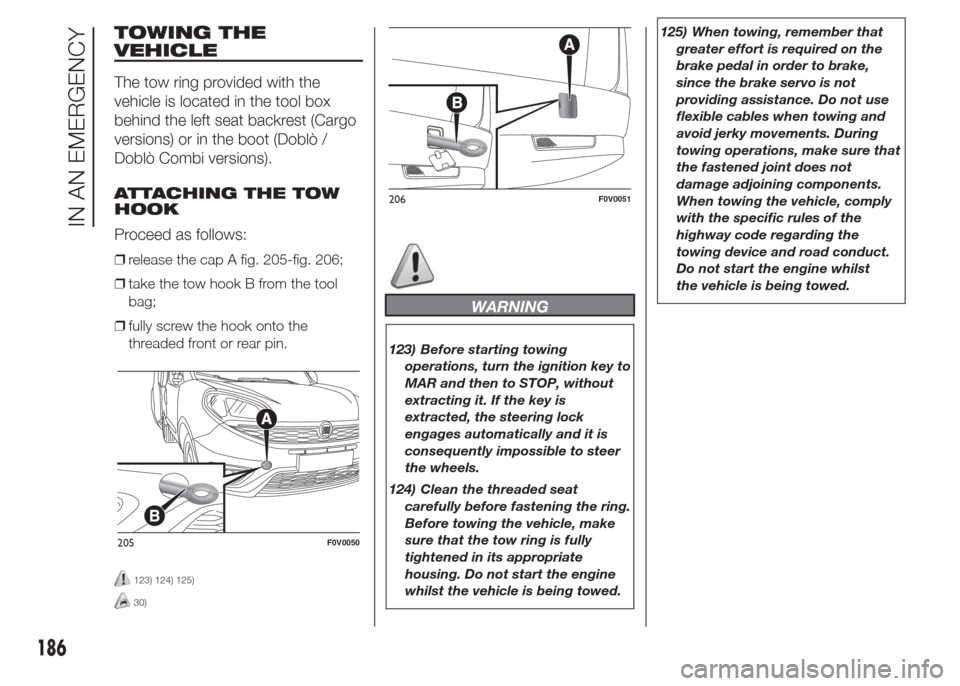
TOWING THE
VEHICLE
The tow ring provided with the
vehicle is located in the tool box
behind the left seat backrest (Cargo
versions) or in the boot (Doblò /
Doblò Combi versions).
ATTACHING THE TOW
HOOK
Proceed as follows:
❒release the cap A fig. 205-fig. 206;
❒take the tow hook B from the tool
bag;
❒fully screw the hook onto the
threaded front or rear pin.
123) 124) 125)
30)
WARNING
123) Before starting towing
operations, turn the ignition key to
MAR and then to STOP, without
extracting it. If the key is
extracted, the steering lock
engages automatically and it is
consequently impossible to steer
the wheels.
124) Clean the threaded seat
carefully before fastening the ring.
Before towing the vehicle, make
sure that the tow ring is fully
tightened in its appropriate
housing. Do not start the engine
whilst the vehicle is being towed.125) When towing, remember that
greater effort is required on the
brake pedal in order to brake,
since the brake servo is not
providing assistance. Do not use
flexible cables when towing and
avoid jerky movements. During
towing operations, make sure that
the fastened joint does not
damage adjoining components.
When towing the vehicle, comply
with the specific rules of the
highway code regarding the
towing device and road conduct.
Do not start the engine whilst
the vehicle is being towed.
205F0V0050
206F0V0051
186
IN AN EMERGENCY
Page 195 of 323
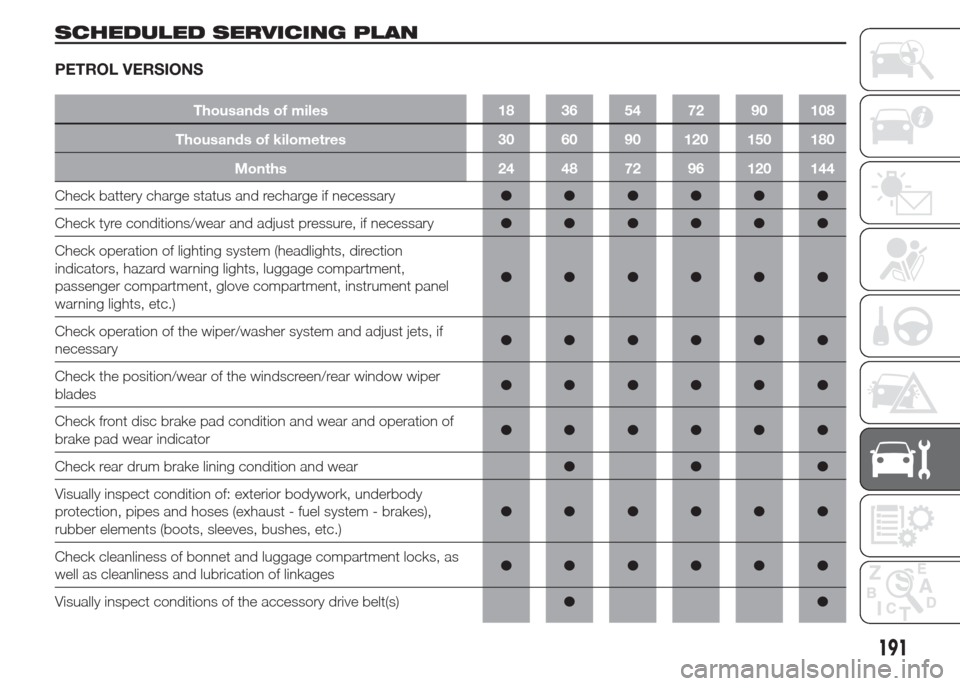
SCHEDULED SERVICING PLAN
PETROL VERSIONS
Thousands of miles 18 36 54 72 90 108
Thousands of kilometres 30 60 90 120 150 180
Months 24 48 72 96 120 144
Check battery charge status and recharge if necessary●●●●●●
Check tyre conditions/wear and adjust pressure, if necessary●●●●●●
Check operation of lighting system (headlights, direction
indicators, hazard warning lights, luggage compartment,
passenger compartment, glove compartment, instrument panel
warning lights, etc.)●●●●●●
Check operation of the wiper/washer system and adjust jets, if
necessary●●●●●●
Check the position/wear of the windscreen/rear window wiper
blades●●●●●●
Check front disc brake pad condition and wear and operation of
brake pad wear indicator●●●●●●
Check rear drum brake lining condition and wear●●●
Visually inspect condition of: exterior bodywork, underbody
protection, pipes and hoses (exhaust - fuel system - brakes),
rubber elements (boots, sleeves, bushes, etc.)●●●●●●
Check cleanliness of bonnet and luggage compartment locks, as
well as cleanliness and lubrication of linkages●●●●●●
Visually inspect conditions of the accessory drive belt(s)●●
191
Page 198 of 323
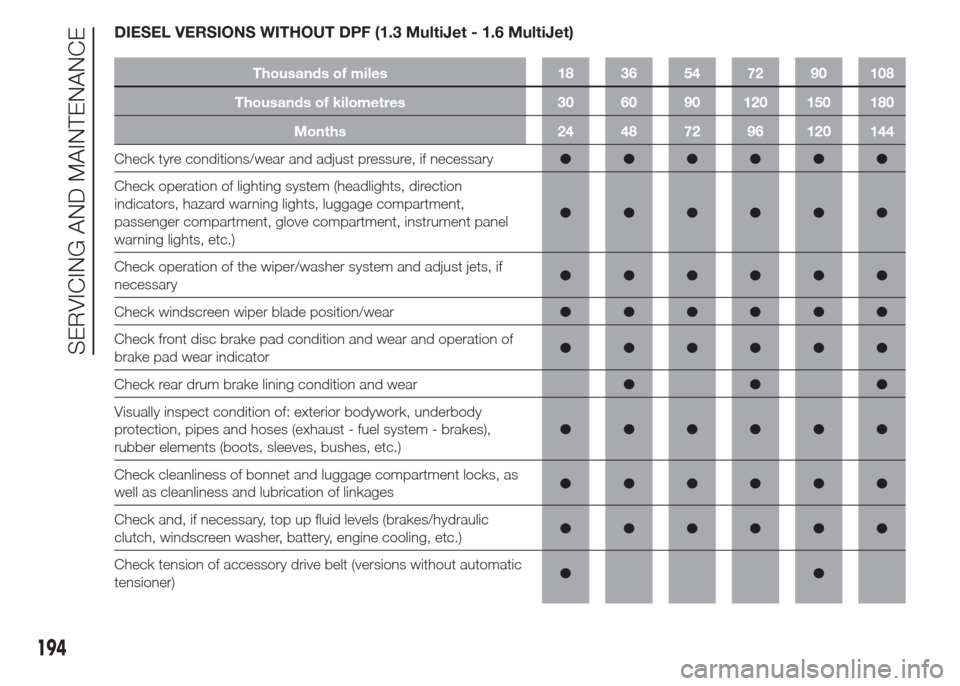
DIESEL VERSIONS WITHOUT DPF (1.3 MultiJet - 1.6 MultiJet)
Thousands of miles 18 36 54 72 90 108
Thousands of kilometres 30 60 90 120 150 180
Months 24 48 72 96 120 144
Check tyre conditions/wear and adjust pressure, if necessary●●●●●●
Check operation of lighting system (headlights, direction
indicators, hazard warning lights, luggage compartment,
passenger compartment, glove compartment, instrument panel
warning lights, etc.)●●●●●●
Check operation of the wiper/washer system and adjust jets, if
necessary●●●●●●
Check windscreen wiper blade position/wear●●●●●●
Check front disc brake pad condition and wear and operation of
brake pad wear indicator●●●●●●
Check rear drum brake lining condition and wear●●●
Visually inspect condition of: exterior bodywork, underbody
protection, pipes and hoses (exhaust - fuel system - brakes),
rubber elements (boots, sleeves, bushes, etc.)●●●●●●
Check cleanliness of bonnet and luggage compartment locks, as
well as cleanliness and lubrication of linkages●●●●●●
Check and, if necessary, top up fluid levels (brakes/hydraulic
clutch, windscreen washer, battery, engine cooling, etc.)●●●●●●
Check tension of accessory drive belt (versions without automatic
tensioner)●●
194
SERVICING AND MAINTENANCE
Page 200 of 323
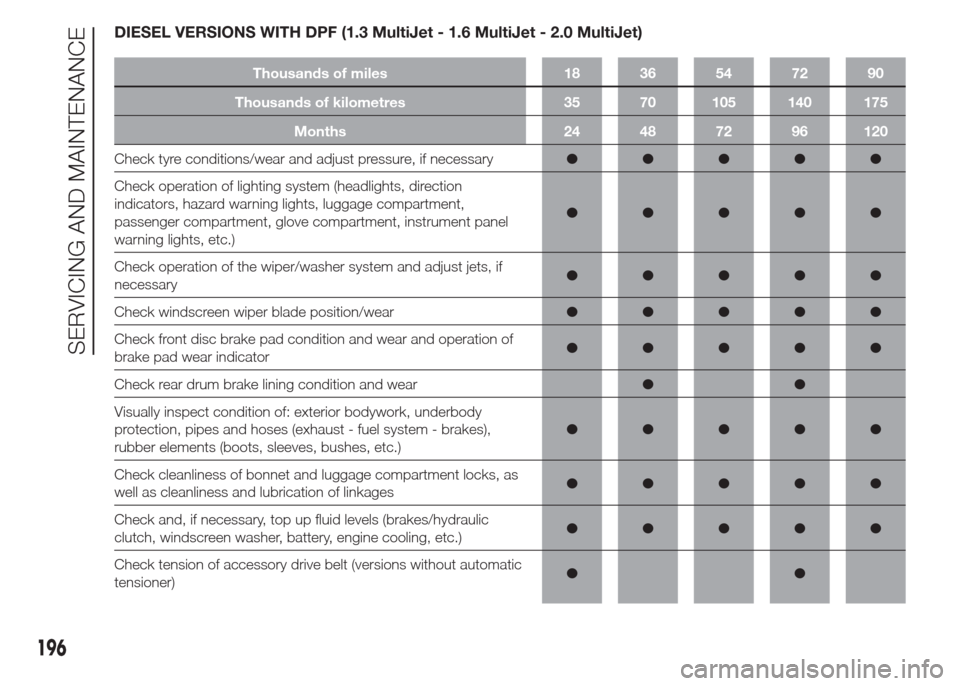
DIESEL VERSIONS WITH DPF (1.3 MultiJet - 1.6 MultiJet - 2.0 MultiJet)
Thousands of miles 18 36 54 72 90
Thousands of kilometres 35 70 105 140 175
Months 24 48 72 96 120
Check tyre conditions/wear and adjust pressure, if necessary●●●●●
Check operation of lighting system (headlights, direction
indicators, hazard warning lights, luggage compartment,
passenger compartment, glove compartment, instrument panel
warning lights, etc.)●●●●●
Check operation of the wiper/washer system and adjust jets, if
necessary●●●●●
Check windscreen wiper blade position/wear●●●●●
Check front disc brake pad condition and wear and operation of
brake pad wear indicator●●●●●
Check rear drum brake lining condition and wear●●
Visually inspect condition of: exterior bodywork, underbody
protection, pipes and hoses (exhaust - fuel system - brakes),
rubber elements (boots, sleeves, bushes, etc.)●●●●●
Check cleanliness of bonnet and luggage compartment locks, as
well as cleanliness and lubrication of linkages●●●●●
Check and, if necessary, top up fluid levels (brakes/hydraulic
clutch, windscreen washer, battery, engine cooling, etc.)●●●●●
Check tension of accessory drive belt (versions without automatic
tensioner)●●
196
SERVICING AND MAINTENANCE
Page 201 of 323
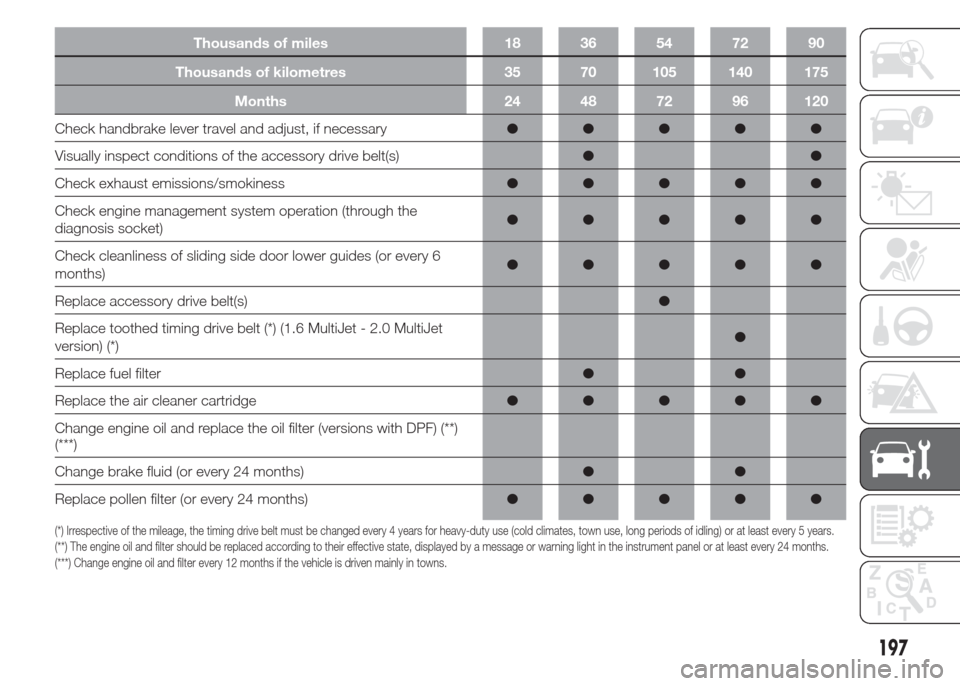
Thousands of miles 18 36 54 72 90
Thousands of kilometres 35 70 105 140 175
Months 24 48 72 96 120
Check handbrake lever travel and adjust, if necessary●●●●●
Visually inspect conditions of the accessory drive belt(s)●●
Check exhaust emissions/smokiness●●●●●
Check engine management system operation (through the
diagnosis socket)●●●●●
Check cleanliness of sliding side door lower guides (or every 6
months)●●●●●
Replace accessory drive belt(s)●
Replace toothed timing drive belt (*) (1.6 MultiJet - 2.0 MultiJet
version) (*)●
Replace fuel filter●●
Replace the air cleaner cartridge●●●●●
Change engine oil and replace the oil filter (versions with DPF) (**)
(***)
Change brake fluid (or every 24 months)●●
Replace pollen filter (or every 24 months)●●●●●
(*) Irrespective of the mileage, the timing drive belt must be changed every 4 years for heavy-duty use (cold climates, town use, long periods of idling) or at least every 5 years.
(**) The engine oil and filter should be replaced according to their effective state, displayed by a message or warning light in the instrument panel orat least every 24 months.
(***) Change engine oil and filter every 12 months if the vehicle is driven mainly in towns.
197
Page 202 of 323
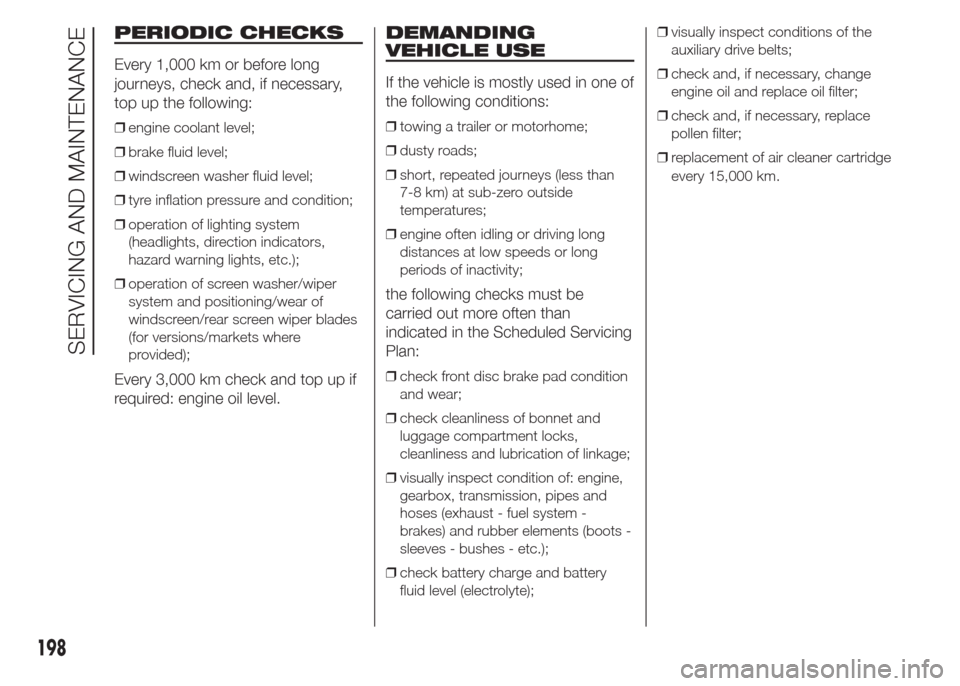
PERIODIC CHECKS
Every 1,000 km or before long
journeys, check and, if necessary,
top up the following:
❒engine coolant level;
❒brake fluid level;
❒windscreen washer fluid level;
❒tyre inflation pressure and condition;
❒operation of lighting system
(headlights, direction indicators,
hazard warning lights, etc.);
❒operation of screen washer/wiper
system and positioning/wear of
windscreen/rear screen wiper blades
(for versions/markets where
provided);
Every 3,000 km check and top up if
required: engine oil level.
DEMANDING
VEHICLE USE
If the vehicle is mostly used in one of
the following conditions:
❒towing a trailer or motorhome;
❒dusty roads;
❒short, repeated journeys (less than
7-8 km) at sub-zero outside
temperatures;
❒engine often idling or driving long
distances at low speeds or long
periods of inactivity;
the following checks must be
carried out more often than
indicated in the Scheduled Servicing
Plan:
❒check front disc brake pad condition
and wear;
❒check cleanliness of bonnet and
luggage compartment locks,
cleanliness and lubrication of linkage;
❒visually inspect condition of: engine,
gearbox, transmission, pipes and
hoses (exhaust - fuel system -
brakes) and rubber elements (boots -
sleeves - bushes - etc.);
❒check battery charge and battery
fluid level (electrolyte);❒visually inspect conditions of the
auxiliary drive belts;
❒check and, if necessary, change
engine oil and replace oil filter;
❒check and, if necessary, replace
pollen filter;
❒replacement of air cleaner cartridge
every 15,000 km.
198
SERVICING AND MAINTENANCE
Page 210 of 323
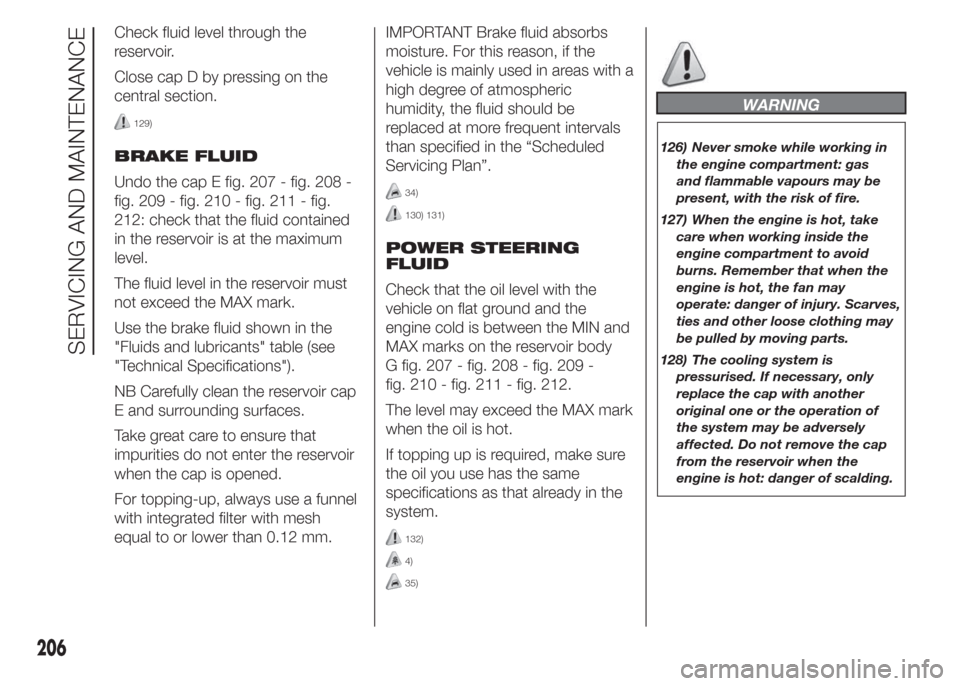
Check fluid level through the
reservoir.
Close cap D by pressing on the
central section.
129)
BRAKE FLUID
Undo the cap E fig. 207 - fig. 208 -
fig. 209 - fig. 210 - fig. 211 - fig.
212: check that the fluid contained
in the reservoir is at the maximum
level.
The fluid level in the reservoir must
not exceed the MAX mark.
Use the brake fluid shown in the
"Fluids and lubricants" table (see
"Technical Specifications").
NB Carefully clean the reservoir cap
E and surrounding surfaces.
Take great care to ensure that
impurities do not enter the reservoir
when the cap is opened.
For topping-up, always use a funnel
with integrated filter with mesh
equal to or lower than 0.12 mm.IMPORTANT Brake fluid absorbs
moisture. For this reason, if the
vehicle is mainly used in areas with a
high degree of atmospheric
humidity, the fluid should be
replaced at more frequent intervals
than specified in the “Scheduled
Servicing Plan”.
34)
130) 131)
POWER STEERING
FLUID
Check that the oil level with the
vehicle on flat ground and the
engine cold is between the MIN and
MAX marks on the reservoir body
G fig. 207 - fig. 208 - fig. 209 -
fig. 210 - fig. 211 - fig. 212.
The level may exceed the MAX mark
when the oil is hot.
If topping up is required, make sure
the oil you use has the same
specifications as that already in the
system.
132)
4)
35)
WARNING
126) Never smoke while working in
the engine compartment: gas
and flammable vapours may be
present, with the risk of fire.
127) When the engine is hot, take
care when working inside the
engine compartment to avoid
burns. Remember that when the
engine is hot, the fan may
operate: danger of injury. Scarves,
ties and other loose clothing may
be pulled by moving parts.
128) The cooling system is
pressurised. If necessary, only
replace the cap with another
original one or the operation of
the system may be adversely
affected. Do not remove the cap
from the reservoir when the
engine is hot: danger of scalding.
206
SERVICING AND MAINTENANCE
Page 212 of 323
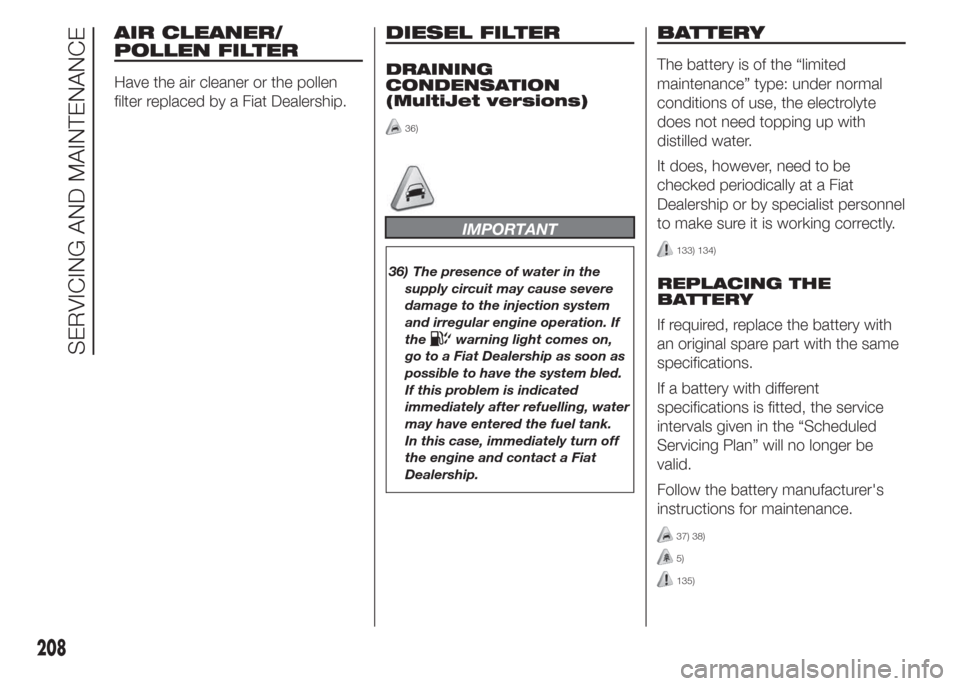
AIR CLEANER/
POLLEN FILTER
Have the air cleaner or the pollen
filter replaced by a Fiat Dealership.
DIESEL FILTER
DRAINING
CONDENSATION
(MultiJet versions)
36)
IMPORTANT
36) The presence of water in the
supply circuit may cause severe
damage to the injection system
and irregular engine operation. If
the
warning light comes on,
go to a Fiat Dealership as soon as
possible to have the system bled.
If this problem is indicated
immediately after refuelling, water
may have entered the fuel tank.
In this case, immediately turn off
the engine and contact a Fiat
Dealership.
BATTERY
The battery is of the “limited
maintenance” type: under normal
conditions of use, the electrolyte
does not need topping up with
distilled water.
It does, however, need to be
checked periodically at a Fiat
Dealership or by specialist personnel
to make sure it is working correctly.
133) 134)
REPLACING THE
BATTERY
If required, replace the battery with
an original spare part with the same
specifications.
If a battery with different
specifications is fitted, the service
intervals given in the “Scheduled
Servicing Plan” will no longer be
valid.
Follow the battery manufacturer's
instructions for maintenance.
37) 38)
5)
135)
208
SERVICING AND MAINTENANCE
Page 213 of 323
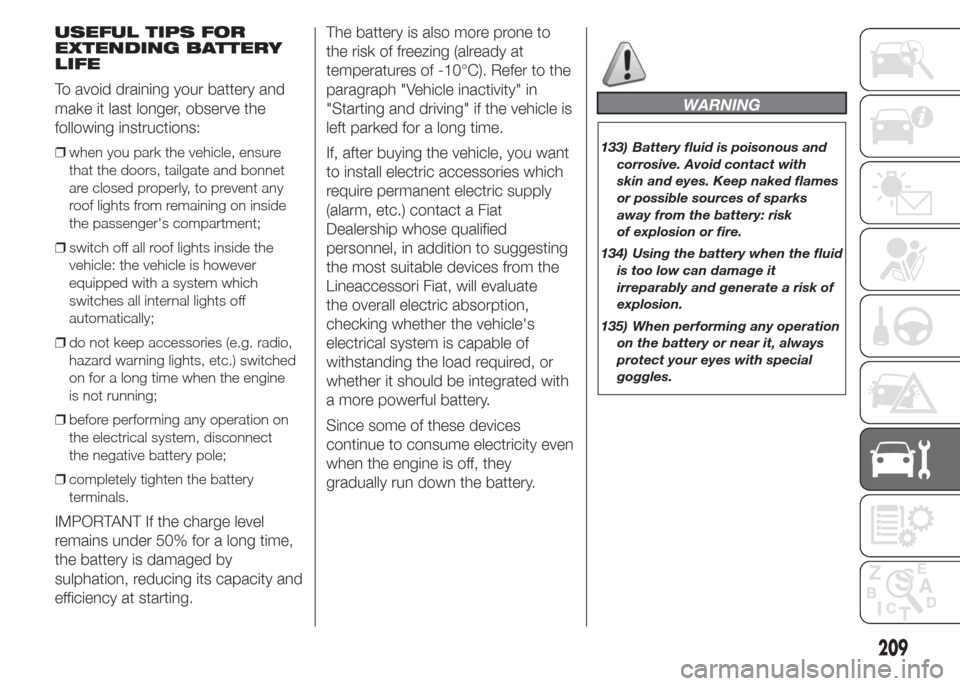
USEFUL TIPS FOR
EXTENDING BATTERY
LIFE
To avoid draining your battery and
make it last longer, observe the
following instructions:
❒when you park the vehicle, ensure
that the doors, tailgate and bonnet
are closed properly, to prevent any
roof lights from remaining on inside
the passenger's compartment;
❒switch off all roof lights inside the
vehicle: the vehicle is however
equipped with a system which
switches all internal lights off
automatically;
❒do not keep accessories (e.g. radio,
hazard warning lights, etc.) switched
on for a long time when the engine
is not running;
❒before performing any operation on
the electrical system, disconnect
the negative battery pole;
❒completely tighten the battery
terminals.
IMPORTANT If the charge level
remains under 50% for a long time,
the battery is damaged by
sulphation, reducing its capacity and
efficiency at starting.The battery is also more prone to
the risk of freezing (already at
temperatures of -10°C). Refer to the
paragraph "Vehicle inactivity" in
"Starting and driving" if the vehicle is
left parked for a long time.
If, after buying the vehicle, you want
to install electric accessories which
require permanent electric supply
(alarm, etc.) contact a Fiat
Dealership whose qualified
personnel, in addition to suggesting
the most suitable devices from the
Lineaccessori Fiat, will evaluate
the overall electric absorption,
checking whether the vehicle's
electrical system is capable of
withstanding the load required, or
whether it should be integrated with
a more powerful battery.
Since some of these devices
continue to consume electricity even
when the engine is off, they
gradually run down the battery.
WARNING
133) Battery fluid is poisonous and
corrosive. Avoid contact with
skin and eyes. Keep naked flames
or possible sources of sparks
away from the battery: risk
of explosion or fire.
134) Using the battery when the fluid
is too low can damage it
irreparably and generate a risk of
explosion.
135) When performing any operation
on the battery or near it, always
protect your eyes with special
goggles.
209